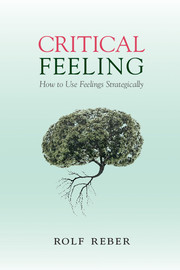2 - The psychology of feelings
from Part I - The basics of critical feeling
Published online by Cambridge University Press: 05 March 2016
Summary
The heart has its reasons, which reason does not know.
(Blaise Pascal 1995/1660, §277)What is a feeling?
What is a feeling? A good way to arrive at a working definition of feeling is to proceed as psychologists of emotion have done (see Reisenzein 2007). They first compiled a list of what has been called emotion in everyday life, such as joy, sadness, anger, and disgust. From this list of emotions, they derived some characteristics common to emotions. Norbert Schwarz provided a list of subjective experiences that encompass feelings. “Human thinking is accompanied by a variety of subjective experiences, including moods and emotions, metacognitive feelings (like ease of recall or fluency of perception), and bodily sensations” (Schwarz 2012, p. 289). We may add to this list affective preferences that take the form of likes and dislikes. Affective preferences are neither emotions nor moods but are based on comparisons between two or more objects. Preferences will therefore be introduced here in their own section, after emotions and moods but before metacognitive feelings and bodily sensations. From this list we can derive characteristics common to all feelings. The most obvious common feature of all feelings is their subjectivity, as noted by Scherer (2005) and Schwarz (2012). Feelings are bound to the person who feels. Although I can infer what you feel or even empathize with you, I never can have your feeling.
Another characteristic of feelings is that their experience is conscious (Laird 2007). We must distinguish between two kinds of consciousness, which Block (1998) called access consciousness and phenomenal consciousness. A feeling is access conscious when a person can both experience the feeling and is aware of it. In this case, we can label or at least circumscribe the feeling. Feelings are phenomenally conscious when a person experiences them without necessarily being able to reflect or even verbalize them. When a person is access conscious of the feeling, the experience is in the foreground, or the focus of attention. If the feeling is phenomenally conscious without being accessible, the experience is in the background, or at the fringes of consciousness (James 1890).
A definition of feelings would be too inclusive if it included sensations (see Overskeid 2000). Seeing red or hearing a musical instrument play a high C are sensations but lack a feeling component – I do not feel red or the high C.
- Type
- Chapter
- Information
- Critical FeelingHow to Use Feelings Strategically, pp. 34 - 59Publisher: Cambridge University PressPrint publication year: 2016

